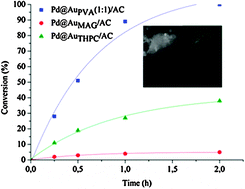Using supported Aunanoparticles as starting material for preparing uniform Au/Pd bimetallic catalysts
Abstract
One of the best methods for producing bulk homogeneous (composition) supported bimetallic

* Corresponding authors
a
Università di Milano, Dipartimento di Chimica Inorganica Metallorganica e Analitica, I-20133 Milano, Italy
E-mail:
Laura.Prati@unimi.it
b
Department of Inorganic Chemistry, Fritz Haber Institute of the Max Planck Society, Faradayweg 4-6, D-14195 Berlin, Germany
E-mail:
dangsheng@fhi-berlin.mpg.de
c Materials Science and Technology Division, Oak Ridge National Laboratory, Oak Ridge, USA
One of the best methods for producing bulk homogeneous (composition) supported bimetallic

 Please wait while we load your content...
Something went wrong. Try again?
Please wait while we load your content...
Something went wrong. Try again?
A. Villa, D. Wang, D. Su, G. M. Veith and L. Prati, Phys. Chem. Chem. Phys., 2010, 12, 2183 DOI: 10.1039/B919322G
To request permission to reproduce material from this article, please go to the Copyright Clearance Center request page.
If you are an author contributing to an RSC publication, you do not need to request permission provided correct acknowledgement is given.
If you are the author of this article, you do not need to request permission to reproduce figures and diagrams provided correct acknowledgement is given. If you want to reproduce the whole article in a third-party publication (excluding your thesis/dissertation for which permission is not required) please go to the Copyright Clearance Center request page.
Read more about how to correctly acknowledge RSC content.
 Fetching data from CrossRef.
Fetching data from CrossRef.
This may take some time to load.
Loading related content
